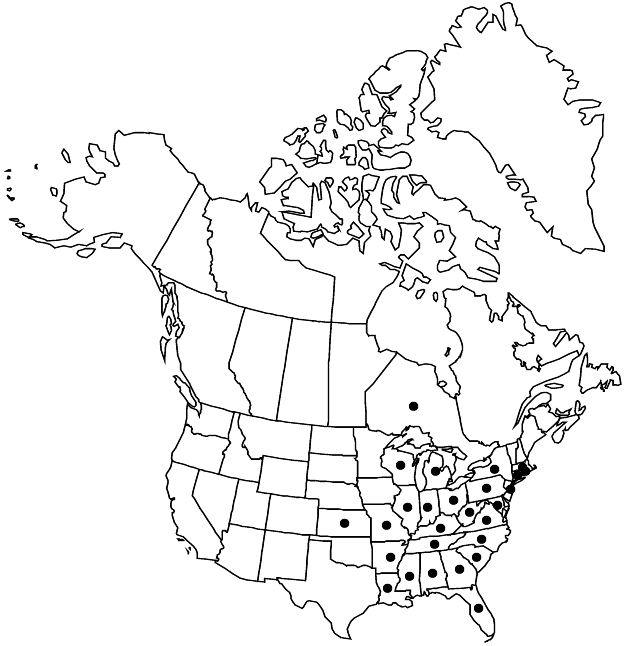Philadelphus inodorus
Sp. Pl. 1: 470. 1753.
Shrubs, 20–40 dm. Stems brown, gray, or stramineous, branched, 20–40 dm, glabrous or very sparsely strigose, especially at nodes; bark reddish, exfoliating or flaking; branches erect to arching; axillary buds hidden in pouches. Leaves: petiole 1–8 mm; blade broadly lanceolate to broadly ovate, or narrowly to broadly elliptic, (3.5–)5–12(–14) × (1.4–)2–5.3(–7) cm, herbaceous, base narrowly cuneate to rounded, margins entire or irregularly to regularly serrate, crenate, or dentate, plane, abaxial surface usually glabrous or moderately strigose, rarely moderately to densely strigose-tomentose in main vein axils, sometimes sparsely strigose on main veins, rarely sparsely strigose on secondary and tertiary veins as well, adaxial surface glabrous or very sparsely strigose, especially near base and margins. Inflorescences cymes or racemes, or flowers solitary, 1–3(–9)-flowered, proximal 2 flowers sometimes in axils of nearly normal to much reduced (bracteal) leaves, if 1-flowered, with articulation between peduncle and pedicel revealing that it is a 1-flowered cyme by reduction. Pedicels 3–8 mm, glabrous or slightly strigose. Flowers: hypanthium usually glabrous, rarely moderately strigose; sepals ovate or ovate-lanceolate, 7–14 × 5–8 mm, apex acuminate to acute, abaxial surface usually glabrous, rarely moderately strigose, adaxial surface glabrous except densely villosulous distally; petals white, oblong, obovate, or orbiculate, 15–25(–30) × 10–22 mm; stamens 60–90; filaments distinct, 5–11 mm; anthers 1–1.5 × 1 mm; styles 4, connate proximally, cylindric, 10–16 mm, lobes 4–8 × 0.8–1 mm; stigmatic surfaces 3–4.5 mm. Capsules obconic to obovoid, 10–13 × 7–10 mm. Seeds caudate, 2–3 mm. 2n = 26.
Phenology: Flowering Apr–May; fruiting Jun–Aug.
Habitat: Stream banks, bluffs, cliffs, rock outcrops.
Elevation: 0–1000 m.
Distribution

Ont., Ala., Ark., Conn., Fla., Ga., Ill., Ind., Kans., Ky., La., Md., Mass., Mich., Miss., Mo., N.J., N.Y., N.C., Ohio, Pa., R.I., S.C., Tenn., Va., W.Va., Wis.
Discussion
The native distribution of Philadelphus inodorus was originally narrower than the current range. It is native in Alabama, Florida, Georgia, Kentucky, Mississippi, North Carolina, South Carolina, Tennessee, Virginia, and West Virginia, whereas it is considered introduced in the remaining places listed.
Selected References
None.